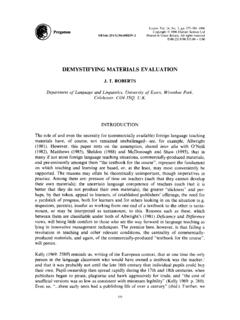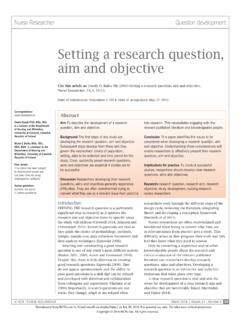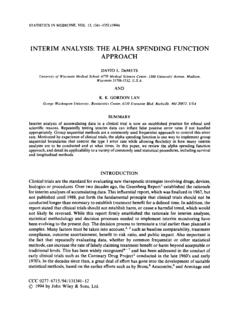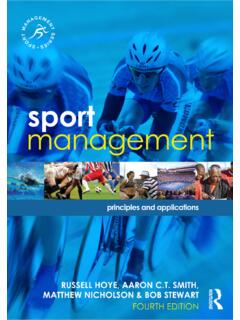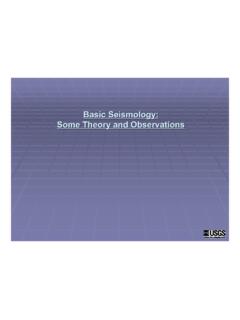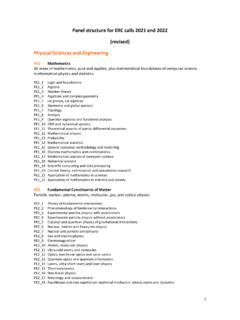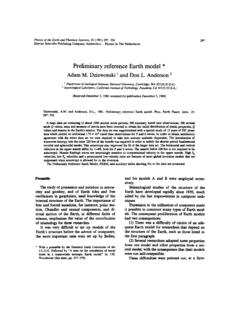Transcription of Fundamentals of Geophysics, Second Edition
1 Fundamentals of GeophysicsSecond EditionThis Second Edition ofFundamentals of Geophysicshas been completely revised andupdated, and is the ideal geophysics textbook for undergraduate students of geosciencewith only an introductory level of knowledge in physics and a comprehensive overview of the fundamental principles of each majorbranch of geophysics (gravity, seismology , geochronology, thermodynamics,geoelectricity, and geomagnetism), this text also considers geophysics within the widercontext of plate tectonics, geodynamics, and planetary science. Basic principles areexplained with the aid of numerous figures, and important geophysical results areillustrated with examples from scientific literature. Step-by-step mathematicaltreatments are given where necessary, allowing students to easily follow the boxes highlight topics of interest for more advanced chapter contains a short historical summary and ends with a reading list thatdirects students to a range of simpler, alternative, or more advanced, resources.
2 Thisnew Edition also includes review questions to help evaluate the reader s understandingof the topics covered, and quantitative exercises at the end of each chapter. Solutions tothe exercises are available to instructors. is Professor Emeritus of Geophysics at the Institute of Geophysics atthe Swiss Federal Institute of Technology (ETH), Z rich, where he has taught andcarried out research for over 30 years. His research interests include rock magnetism,magnetostratigraphy, and tectonic applications of paleomagnetic from Cambridge Books Online by IP on Sat May 18 14:44:24 WEST Books Online Cambridge University Press, 2013 Downloaded from Cambridge Books Online by IP on Sat May 18 14:44:24 WEST Books Online Cambridge University Press, 2013 Fundamentals of GeophysicsSecond EditionWILLIAM LOWRIES wiss Federal Institute of Technology, Z richDownloaded from Cambridge Books Online by IP on Sat May 18 14:44:24 WEST Books Online Cambridge University Press, 2013 CAMBRIDGE UNIVERSITY PRESSC ambridge, New York, Melbourne, Madrid, Cape Town, Singapore, S o PauloCambridge University PressThe Edinburgh Building, Cambridge CB2 8RU, UKFirst published in print formatISBN-13 978-0-521-85902-8 ISBN-13 978-0-521-67596-3 ISBN-13 978-0-511-35273-7 W.
3 Lowrie 20072007 Information on this title: publication is in copyright. Subject to statutory exception and to the provision of relevant collective licensing agreements, no reproduction of any part may take place without the written permission of Cambridge University 0-511-35273-5 ISBN-10 0-521-85902-6 ISBN-10 0-521-67596-0 Cambridge University Press has no responsibility for the persistence or accuracy of urls for external or third-party internet websites referred to in this publication, and does not guarantee that any content on such websites is, or will remain, accurate or in the United States of America by Cambridge University Press, New (Adobe Reader)eBook (Adobe Reader)hardbackDownloaded from Cambridge Books Online by IP on Sat May 18 14:44:24 WEST Books Online Cambridge University Press, 2013 ContentsPrefacepage viiAcknowledgementsix1 The Earth as a The solar The dynamic Suggestions for further Review Exercises412 Gravity, the figure of the Earth and The Earth s size and The Earth s The Earth s figure and Gravity Interpretation of gravity Suggestions for further Review Exercises1183 seismology and the internal structure of the Elasticity Seismic The Earthquake Seismic wave Internal structure of the Suggestions for further Review Exercises2034 Earth s age, thermal and electrical The Earth s Suggestions for further Review Exercises277vDownloaded from Cambridge Books Online by IP on Sat May 18 14:44.
4 40 WEST Books Online Cambridge University Press, 20135 Geomagnetism and Historical The physics of Rock Magnetic Geomagnetic Suggestions for further Review Exercises360 Appendix A The three-dimensional wave equations363 Appendix B Cooling of a semi-infinite half-space366 Bibliography368 Index375viContentsDownloaded from Cambridge Books Online by IP on Sat May 18 14:44:40 WEST Books Online Cambridge University Press, 2013 Preface to the Second editionIn the ten years that have passed since the publication of the first Edition of this text-book exciting advances have taken place in every discipline of improvements in technology have led the way, allowing moresophistication in the acquisition and processing of geophysical data. Advances inmass spectrometry have made it possible to analyze minute samples of matter inexquisite detail and have contributed to an improved understanding of the origin ofour planet and the evolution of the solar system.
5 Space research has led to betterknowledge of the other planets in the solar system, and has revealed distant objectsin orbit around the Sun. As a result, the definition of a planet has been technology has provided more refined measurement of the gravityand magnetic fields of the Earth, and has enabled direct observation from space ofminute surface changes related to volcanic and tectonic events. The structure , com-position and dynamic behavior of the deep interior of the Earth have become betterunderstood owing to refinements in seismic tomography. Fast computers andsophisticated algorithms have allowed scientists to construct plausible models ofslow geodynamic behavior in the Earth s mantle and core, and to elucidate theprocesses giving rise to the Earth s magnetic field. The application of advancedcomputer analysis in high-resolution seismic reflection and ground-penetratingradar investigations has made it possible to describe subtle features of environmen-tal interest in near-surface structures.
6 Rock magnetic techniques applied to sedi-ments have helped us to understand slow natural processes as well as more rapidanthropological changes that affect our environment, and to evaluate climates in thedistant geological past. Climatic history in the more recent past can now be deducedfrom the analysis of temperature in the many advances in geophysical research depend strongly on the aidof computer science, the fundamental principles of geophysical methods remain thesame; they constitute the foundation on which progress is based. In revising thistextbook, I have heeded the advice of teachers who have used it and who recom-mended that I change as little as possible and only as much as necessary (to para-phrase medical advice on the use of medication). The reviews of the first Edition , thefeedback from numerous students and teachers, and the advice of friends and col-leagues helped me greatly in deciding what to structure of the book has been changed slightly compared to the firstedition.
7 The final chapter on geodynamics has been removed and its contents inte-grated into the earlier chapters, where they fit better. Text-boxes have been intro-duced to handle material that merited further explanation, or more extensivetreatment than seemed appropriate for the body of the text. Two appendices havebeen added to handle more adequately the three-dimensional wave equation and thecooling of a half-space, respectively. At the end of each chapter is a list of reviewquestions that should help students to evaluate their knowledge of what they haveread. Each chapter is also accompanied by a set of exercises. They are intended toprovide practice in handling some of the numerical aspects of the topics discussedviiDownloaded from Cambridge Books Online by IP on Sat May 18 14:44:53 WEST Books Online Cambridge University Press, 2013in the chapter. They should help the student to become more familiar with geophys-ical techniques and to develop a better understanding of the fundamental first Edition was mostly free of errata, in large measure because of thepatient, accurate and meticulous proofreading by my wife Marcia, whom I sincerelythank.
8 Some mistakes still occurred, mostly in the more than 350 equations, andwere spotted and communicated to me by colleagues and students in time to be cor-rected in the Second printing of the first Edition . Regarding the students, this did notimprove (or harm) their grades, but I was impressed and pleased that they werereading the book so carefully. Among the colleagues, I especially thank BobCarmichael for painstakingly listing many corrections and Ray Brown for posingimportant questions. Constructive criticisms and useful suggestions for additionsand changes to the individual revised chapters in this Edition were made by MarkBukowinski, Clark Wilson, Doug Christensen, Jim Dewey, Henry Pollack,Ladislaus Rybach, Chris Heinrich, Hans-Ruedi Maurer and Mike Fuller. I am verygrateful to these colleagues for the time they expended and their unselfish efforts tohelp me. If errors persist in this Edition , it is not their fault but due to my publisher of this textbook, Cambridge University Press, is a not-for-profitcharitable institution.
9 One of their activities is to promote academic literature in the third world. With my agreement, they decided to publish a separate low-costversion of the first Edition , for sale only in developing countries. This versionaccounted for about one-third of the sales of the first Edition . As a result, earthscience students in developing countries could be helped in their studies of geo-physics; several sent me appreciative messages, which I bulk of this Edition has been written following my retirement two years ago,after 30 years as professor of geophysics at ETH Z rich. My new emeritus statusshould have provided lots of time for the project, but somehow it took longer than Iexpected. My wife Marcia exhibited her usual forbearance and understanding formy obsession. I thank her for her support, encouragement and practical sugges-tions, which have been as important for this as for the first Edition .
10 This Edition isdedicated to her, as well as to my late LowrieZ richAugust, 2006viiiPrefaceDownloaded from Cambridge Books Online by IP on Sat May 18 14:44:53 WEST Books Online Cambridge University Press, 2013 AcknowledgementsThe publishers and individuals listed below are gratefully acknowledged for giving theirpermission to use redrawn figures based on illustrations in journals and books for whichthey hold the copyright. The original authors of the figures are cited in the figure cap-tions, and I thank them also for their permissions to use the figures. Every effort hasbeen made to obtain permission to use copyrighted materials, and sincere apologies arerendered for any errors or omissions. The publishers would welcome these being broughtto their ownerFigure numberAmerican Association for the Advancement of , , , , Geophysical UnionGeodynamics Research of Geophysical , , , , , , , , , , , , , , , , , , , , , , Ewing of , , , Review of Earth and Planetary , , Scientific Publications , , Journal of the Royal Astronomical Societyand Geophysical Journal , , , , R.
